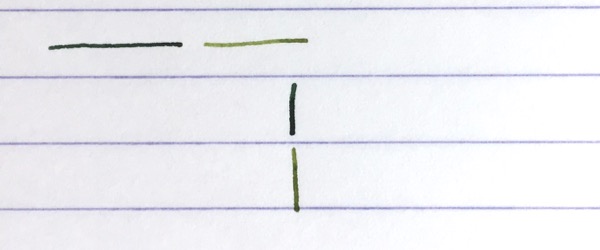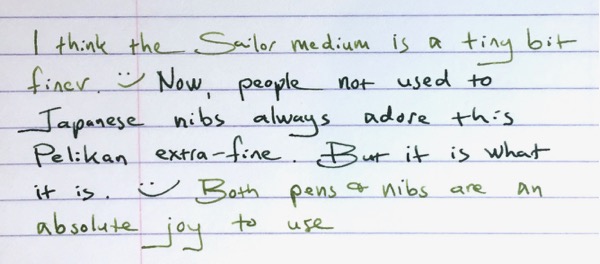How fine is the Pelikan M600 extra-fine nib? Not very! At least, not “very fine” in the sense of “narrow.” But “very fine” in the sense of “excellent.”
I happen to have a Pelikan M600 with extra-fine nib inked up at the same time as a Sailor 1911L with medium nib. The two pens have different inks, but here’s a comparison writing sample.

I’m not particularly surprised by this. I often use two modern M600 Pelikans with extra-fine nibs, and I always jokingly call those nibs “alleged extra-fines.”
Partly that’s because I tend to think of nib widths in line with vintage Parkers and Pelikans, and modern Japanese pens — all of which run narrower than modern Pelikan gold nibs. But also because I use a lot of modern Pelikan fine nibs, and I find those pretty darn close to Pelikan extra-fine nibs. In fact, I swear that a few of my Pelikan fines write a narrower line.*
Here’s another writing sample. The Pelikan gold extra-fine uses the dark green of Pelikan Edelstein Olivine, and the Sailor medium is inked with the lighter green of Sailor Waka-Uguisu.

I bring this up now because Pelikan has decided to start charging extra for their extra-fine nibs. They apparently implemented the price increase in Europe earlier this year, and it just reached the US with the M600 Vibrant Orange, which will cost $440 with fine through broad nibs, versus $476 with an extra-fine nib.
I’ve never bought many Pelikan extra-fine nibs. I tend to use vintage fine nibs and modern Japanese fine and extra-fine nibs when I want a finer lines. So my extra-fine nib needs are covered. But I don’t think Pelikan extra-fine gold nibs are bad, just because they may be wider. In fact, I think Pelikan’s gold extra-fine nibs are very good.
To me, what makes Pelikan’s gold extra-fine nibs good, and maybe a little special, is that they are extremely smooth and easy writers. I’ve noticed that people who don’t share my love of very narrow nibs always love my Pelikan extra-fines.
Modern Pelikan gold nibs are beautifully ground to almost float on the page, so you can write very fluidly with them, and they reward a light touch. That’s true for the extra-fine, as well. Sure, it may write wider than many extra-fine nibs, but it also writes wetter and smoother.**
Sailor gold nib also are beautifully ground, but at size medium and below, Sailor nibs feature a characteristic feedback. Instead of floating across the page, a Sailor nib feels more like writing with a pencil — it’s a different kind of smoothness. Or look to the extra-fine nibs of Lamy and Aurora: in those the extra-fine nib tends to have a smaller sweet spot and put less ink down on the paper. All these brands’s extra-fines will generally write finer than Pelikan’s gold extra-fine, but the experience is different.
So I can think of a lot of reasons why many fountain pen users prefer the Pelikan extra-fine.
And even though it’s not particularly narrow, I enjoy using it myself. I’m not sure it’s different enough from the Pelikan gold fine nib for me to buy another, given the price increase, but I’d heartily recommend it to those who don’t already own one, especially those who don’t necessarily seek the narrowest line possible.

————–
*Please note that I’m only talking about modern Pelikan gold nibs here. Modern Pelikan gold nibs differ from (i) the steel nibs found on pens like the M200 line, and (ii) vintage Pelikan nibs.
**There will be sample variations in any nib, so these are generalized statements based on my experience across a range of pens. Some individual extra-fine gold nibs from Pelikan may be narrower or dryer, than normal, or may exhibit other variances.

I’m glad you mentioned Pelikan’s steel nibs. I was just thinking it, when I saw your comment that their steel nibs are different. I have an M200 with a steel XF nib, and it really is XF. And it writes beautifully, too. That’s the beauty of Pelikan – all their nibs write beautifully, regardless of width.
LikeLiked by 1 person
I agree, on both counts. 😊
LikeLike
This is all so very true! From what I can see amongst my pens, there is almost no difference between the line widths of my Sailor 1911 broad nibs, and a couple of Parker mediums; and the “so-called” fine nib of a Waterman Carene is almost indistinguishable from a medium Lamy 2000 (now that the latter actually writes), and produces a wider, wetter line, than a medium Platinum 3776. And all of the above seem to come up just a touch wider than any of my Pilots with equivalent nib sizes… except the Falcon, which differs again, because of its weird nib… I get so confused.
This is why I find getting to brick and mortar pen shops every now and then such a great opportunity for testing. I so envy you your pen show and hub opportunities for trying out the different makes and models.
PS. slightlyunnerved >> I had a broad Sailor 1911L converted to a medium stub by Mike Masuyama, it took about five months, but was actually less time than he quoted, and was the best thing I could have done! Well worth it!
LikeLiked by 3 people
Thanks for the heads up. Nib-fettlers are a bit thin on the ground in the UK, but I have contact details for someone and will see what they have to say.
I know what you mean about variation in nib widths. I’ve learnt that in most cases, it’s just a guide and that trying to compare (say) the medium nib from one manufacturer with another is pretty much a waste of time. I’ve even found that nominally the same nib width on different TWSBI models are different 😳. The former scientist in me really struggles to cope with stub nibs and the fact that 1.1mm is almost never 1.1mm. If you measure a nib size in mm, that implies a certain level of precision. I know it’s not that simple, but it does hurt my head from time to time.
LikeLiked by 3 people
Yeah, there are sample variations even within the same size by the same manufacturer, even with stainless steel nibs that aren’t individually ground. 😊 And that doesn’t even mention the effect of different inks, different papers and different people’s writing style (light touch versus heavy, how each of us orients the nib, etc.),
I wonder if one reason fountain pens can be so endlessly fascinating is how much more the human element comes into play? On the bright side. 😊
LikeLiked by 2 people
Indeed. Everyone has different likes and dislikes and the key thing is that’s absolutely fine. When I was thinking of starting my blog, I was wondering whether I had anything to add to the general discourse. Then I read something you wrote in response to someone’s criticism of one of your reviews which questioned your objectivity. It helped me realise that it’s fine to be subjective and it’s actually how people use and interact with their pens and inks that really matters. Thanks – it’s all your fault! 😀
LikeLiked by 2 people
Ha. Well thank you, too! That made my day!
LikeLiked by 2 people
Happy to oblige!
LikeLiked by 1 person
I plan to get a Pelikan in the future and I was wondering which nib size I should go for! Your post has been very useful, thank you! 🙂 I now know I’ll choose an extra-fine because I love the M nib of my Sailor and I wanted to have something similar.
LikeLiked by 2 people
You are very welcome! That’s great to hear. 😊
LikeLiked by 2 people
Very useful info for future reference. Thank you!
LikeLiked by 2 people
You’re welcome!
LikeLiked by 1 person
Interesting post. I get the argument from Pelikan that EF nibs cost more to produce, but does it really hit their margins that much? Stil, they could have just jacked the price of all their nibs up and penalised all their customers!
I’ve recently bought an M400 with a fine nib. It’s not really very fine at all (in line width terms – it writes brilliantly), but I’ve found I can tune it a bit by choice of ink. First time out I tried Iroshizuku Kon peki and got a ridiculously wide line. Switching to Callifolio Baikal has done a great job of holding things back and giving me a much narrower line (without an obvious penalty in terms of flow or ease of writing). I have a couple of inks that I think of as more arid than dry, so I might give these a whirl and see how much more I can narrow the line by…
LikeLiked by 3 people
You are so right about the inks. Ink and paper make a huge difference in the effective nib width. I happen to love a dry-writing ink, which places me outside the mainstream, a little. And the main reason is: Pelikans! 😊 Especially vintage Pelikans, which are absolute gushers. Needing to find dry inks for wetter pens is how I first got into iron gall inks. But any dry-writing ink, in the right pen, gives you a nice precision of line, works better on poor paper and dries more quickly. Because I write mostly for work, I need all those things.
The inks in these two pens, by the way, have similar lubrication and wetter flow.
I don’t like any price increases, but I always think, “better than not having the product at all.” So I guess I don’t mind Pelikan charging more for the EF if it costs more. Lamy does the same thing. I’m assuming that the failure and service/return rate is higher on those, since a lot of dissatisfaction can be traced to user error, and EF nibs require more precision of the user. That goes into the “higher cost” equation, but no company wants to say that. Honestly, because of ballpoints, I see an astounding number of practiced and experienced fountain pen users who use way too much pressure on fountain pen nibs, mashing down instead of writing with a light touch. That’s got to be much worse on EF nibs (also on soft or flex nibs).
LikeLiked by 3 people
I usually prefer wetter inks, but since I got my Pelikan some of the drier ones have risen in the popularity stakes (Diamine Chopin is an interesting one). I’m taking a similar approach with my Sailor Pro Gear Earth. I picked a broad nib and have regretted that decision ever since. Drier inks have helped reduce the line width , but when budget allows I’m going to see about having the nib re-ground.
It never ceases to amaze me how little pressure you need to apply with a fountain pen. I’m fortunate that I can usually manage to completely avoid using a ballpoint. Most of my writing is done at work, but I cope with it by buying my own notebooks, which enables me to use a fountain pen pretty much all of the time. 👍😀👍
Fair point on the EF question. I guess it’s one of those things. It’s easy to forget that fountain pen ownership and use is (comparatively) a minority activity, so we probably should be grateful there are still as many players in the market as there are. It could be worse, much worse…
LikeLiked by 3 people
That is a really good point. So many brands are gone, and others are a mere shell.
LikeLiked by 2 people